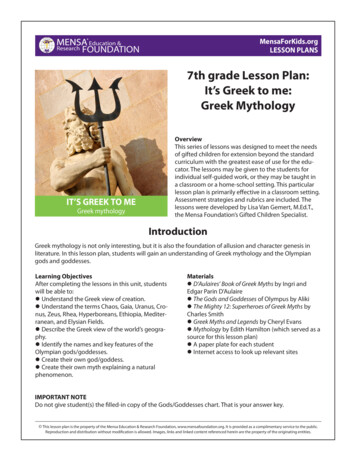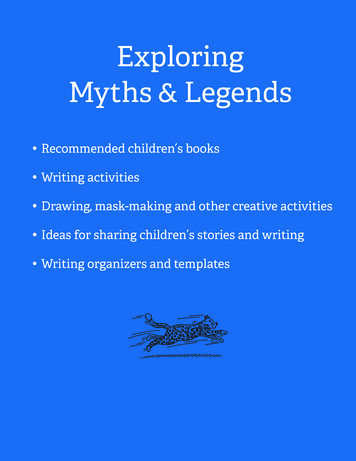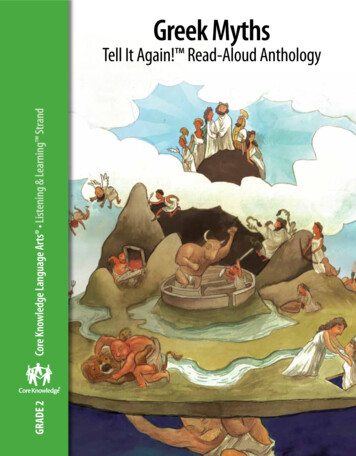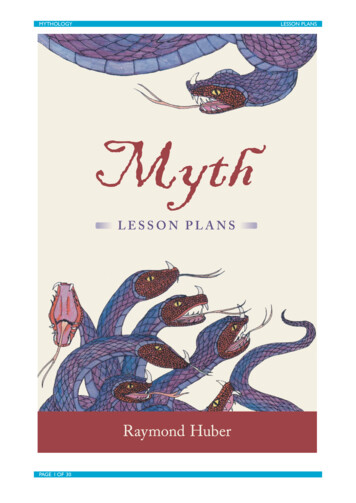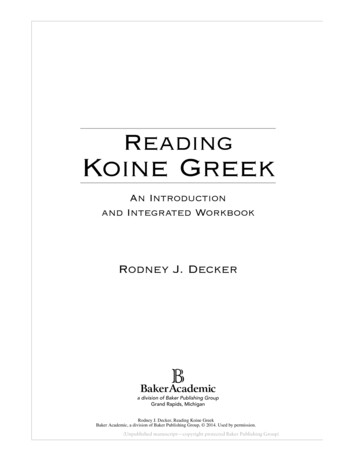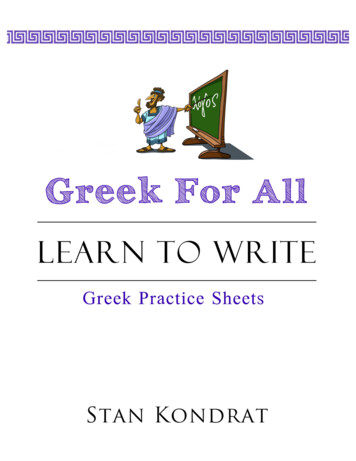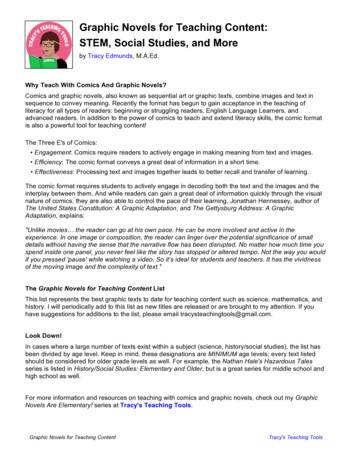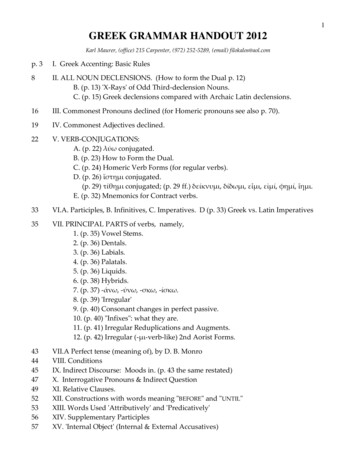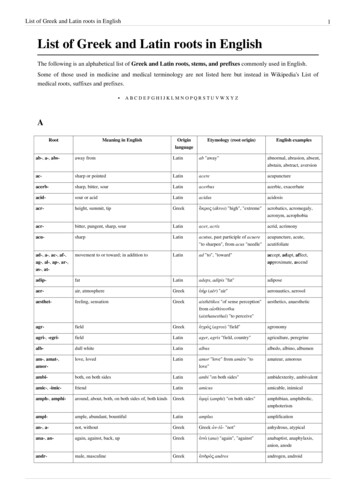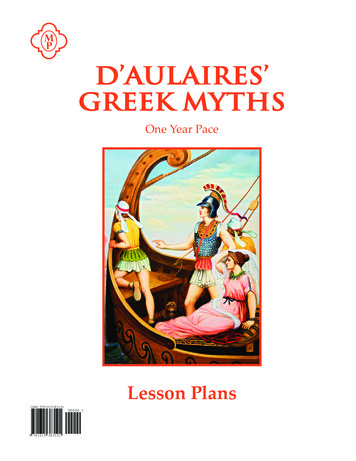
Transcription
D’Aulaires’Greek MythsOne Year PaceLesson PlansISBN 978161538319190000 9 781615 383191
www.MemoriaPress.comD’Aulaires’ Greek MythsOne Year Pace Lesson PlansMemoria Presswww.memoriapress.comISBN 978-1-61538-319-1First Edition 2013 Memoria Press All rights reserved. No part of this book may be reproduced in any formby any means without written permission from the publisher.
D’AULAIRES’ GREEK MYTHSBEFORE YOU READ:RecitationStudents stand and recite the Facts to Know from previous lessons. The teacher gives the word inbold print and students say the corresponding definition. Or the teacher may give the definition andstudents say the corresponding Fact to Know.LessonPreview Facts to Know.The teacher gives the name on the left, and students reply in unison with the definition on the right.Help students with pronunciation. (Point out to students the pronunciation guide found in the back of their study guide.)Preview Vocabulary and Comprehension Questions to encourage purposeful reading.READING:Read the pages for the assigned lesson in D’Aulaires’ Book of Greek Myths. We recommend forthird grade that the teacher reads the book orally and students follow along, as the vocabulary ischallenging and may be beyond their current reading abilities.Periodically stop reading to discuss difficult concepts, to summarize the plot, and to discuss anycorresponding pictures.While reading, stop at each vocabulary word and record the word’s meaning in the students’ studyguides. Use students’ knowledge of Latin and other vocabulary to decipher meanings.AFTER YOU READ:Comprehension QuestionsAnswer Comprehension Questions together as a class. Call on a student to answer each questionaloud. The teacher edits the answer and writes it on the board, using good sentence structure.Students copy this answer, word for word, into their study guide. Remind students to be mindful ofcopying accurately.It is not necessary to write the answer to every question; some of them may be answered orally.Just make sure you answer the questions that will appear on tests so that students will have theinformation they need to study.ActivitiesThe activities are mainly enrichment exercises. They are not essential to a student’s understanding ofthe material taught in the stories. They can be used as writing assignments, research projects, and artwork as time and interest allow.Discuss map locations: Locate places mentioned in the text on a world map or globe. Then find thelocations on the unit map(s) provided in the study guide at the end of each unit. Students highlightlocations on the unit map(s) and write in the significance of each location.If applicable, add to the Greek Myths Lists in the Appendix of the study guide any characters fromtoday’s reading.Discuss any other questions listed.3
D'AULAIRES' GREEK MYTHS4REVIEWComplete the entire lesson together: vocabulary, short answer, matching, map work.Or you may wish to assign the review pages to be completed independently and correct students’answers together.Drill specific Facts to Know, vocabulary, questions, or map locations as needed for retention.Use any extra time to play a review game.Game suggestions: Jeopardy (This will need to be prepared ahead of time.)20 Questions (to guess a particular mythological character)TESTSAs you proceed through each lesson, it is recommended that you have students highlight theparticular vocabulary words, Facts to Know, and Comprehension Questions they will need to knowfor the unit test. Memorizing all of them could be overwhelming for a typical third grader.NOTE: We do not require students to learn the correct spelling for the primary 12 Olympic godsand goddesses. Students should do the best they can do, and these spellings should be practicedoccasionally in class, but incorrect spelling does not affect a student’s grade.
5
DAY 1WEEKDAY 2 D’Aulaires’ Greek Myths,Lesson 1 (partial lesson)1DAY 3 D’Aulaires’ Greek Myths Review Facts to Know, Lesson 1 Preview text and study guide.Read through Table of Contents.Preview text illustrations, esp.pp. 22-23. Facts to Know (all) Vocabulary (all) Read text pp. 9-11 Comprehension Question #1*Familiarize yourself with the TeachingGuidelines in these lesson plans and in theD’Aulaires’ Greek Myths Teacher Manual. D'Aulaires' Greek Myths,Lesson 1 Facts to Know (review)2 Vocabulary (review)Read text pp. 9-15Comprehension Questions #2-6Map work D'Aulaires' Greek Myths,Lesson 1 D'Aulaires' Greek Myths Review Facts to Know, Lesson 1 Drill Questions**Drill Questions are located in the Appendixof this Study Guide Activities (as time allows) D'Aulaires' Greek Myths,Lesson 23 Facts to KnowVocabularyRead text pp. 16-21Comprehension QuestionsMap work D'Aulaires' Greek Myths,Lesson 2 Drill Questions D'Aulaires' Greek Myths Review Facts to Know, Lessons1-2 Activities (as time allows) D'Aulaires' Greek Myths,Lesson 34 D'Aulaires' Greek Myths Review Facts to Know, Lessons1-3Facts to KnowVocabularyRead text pp. 22-23Comprehension Questions Activities (as time allows) D'Aulaires' Greek Myths,Lesson 45 Facts to KnowVocabularyRead text pp. 24-29Comprehension QuestionsMap work Activities (as time allows)6 D'Aulaires' Greek Myths,Lesson 4 Drill Questions D'Aulaires' Greek Myths Review Facts to Know, Lessons1-4
DAY 1WEEK D'Aulaires' Greek Myths,Lesson 56 Facts to KnowVocabularyRead text pp. 30-37Comprehension QuestionsMap workDAY 2DAY 3 D'Aulaires' Greek Myths,Lesson 5 D'Aulaires' Greek Myths D'Aulaires' Greek Myths D'Aulaires' Greek Myths Drill Questions Review Facts to Know, Lessons1-5 Activities (as time allows) D'Aulaires' Greek Myths,Review Lesson (Lessons 1-5)7 Complete study guide exercises. Study Facts to Know,Vocabulary, ComprehensionQuestions, Drill Questions;Lessons 1-5 Study map: locations andsignificance; Lessons 1-5 D'Aulaires' Greek Myths,Lesson 68 Facts to KnowVocabularyRead text pp. 38-43Comprehension QuestionsMap work Go over Review Lesson 1-5orally in preparation for Test I. D'Aulaires' Greek Myths,Lesson 6 Drill Questions Test: Lessons 1-5*See the Teaching Guidelines in theselesson plans for help in preparing andscheduling your unit tests. D'Aulaires' Greek Myths Review Facts to Know, Lesson 6 Drill Questions Review (Lessons1-2) Activities (as time allows) D'Aulaires' Greek Myths,Lesson 79 Facts to KnowVocabularyRead text pp. 44-55Comprehension QuestionsMap work D'Aulaires' Greek Myths,Lesson 7 Drill Questions D'Aulaires' Greek Myths Review Facts to Know, Lessons6-7 Drill Questions Review (Lessons4-5) Activities (as time allows) D'Aulaires' Greek Myths,Lesson 810 Facts to KnowVocabularyRead text pp. 56-63Comprehension QuestionsMap work D'Aulaires' Greek Myths,Lesson 8 Drill Questions D'Aulaires' Greek Myths Review Facts to Know, Lessons6-8 Drill Questions Review (Lessons6-7) Activities (as time allows) D'Aulaires' Greek Myths,Lesson 911 Facts to KnowVocabularyRead text pp. 64-69Comprehension QuestionsMap work D'Aulaires' Greek Myths,Lesson 9 Drill Questions D'Aulaires' Greek Myths Review Facts to Know, Lessons6-9 Activities (as time allows)7
DAY 1WEEK D'Aulaires' Greek Myths,Lesson 1012 Facts to KnowVocabularyRead text pp. 70-73Comprehension QuestionsMap workDAY 2DAY 3 D'Aulaires' Greek Myths,Lesson 10 Drill Questions Activities (as time allows)1314 D'Aulaires' Greek Myths,Review Lesson (Lessons 6-10) D'Aulaires' Greek Myths D'Aulaires' Greek Myths D'Aulaires' Greek Myths,Lesson 11 D'Aulaires' Greek Myths,Lesson 11 D'Aulaires' Greek Myths Complete study guide exercises. Study Facts to Know,Vocabulary, ComprehensionQuestions Drill Questions;Lessons 6-10 Study map: locations andsignificance; Lessons 6-10 Facts to KnowVocabularyRead text pp. 74-79Comprehension QuestionsMap work Go over Review Lesson 6-10orally in preparation for Test II. Drill Questions Test: Lessons 6-10 Review Facts to Know, Lesson 11 Drill Questions Review (Lessons1-4) Activities (as time allows) D'Aulaires' Greek Myths,Lesson 1215 Facts to KnowVocabularyRead text pp. 80-89Comprehension QuestionsMap work D'Aulaires' Greek Myths,Lesson 12 Drill Questions D'Aulaires' Greek Myths Review Facts to Know, Lessons11-12 Drill Questions Review (Lessons5-7) Activities (as time allows) D'Aulaires' Greek Myths,Lesson 1316 Facts to KnowVocabularyRead text pp. 90-95Comprehension QuestionsMap work D'Aulaires' Greek Myths,Lesson 13 Drill Questions D'Aulaires' Greek Myths Review Facts to Know, Lessons11-13 Drill Questions Review (Lessons8-10) Activities (as time allows) D'Aulaires' Greek Myths,Lesson 1417 Facts to KnowVocabularyRead text pp. 96-99Comprehension QuestionsMap work Activities (as time allows)8 D'Aulaires' Greek Myths,Lesson 14 Drill Questions D'Aulaires' Greek Myths Review Facts to Know, Lessons11-14 Drill Questions Review (Lessons11-13)
DAY 1WEEK D'Aulaires' Greek Myths,Lesson 1518 Facts to KnowVocabularyRead text pp. 100-107Comprehension QuestionsMap workDAY 2DAY 3 D'Aulaires' Greek Myths,Lesson 15 Drill Questions Activities (as time allows)1920 D'Aulaires' Greek Myths,Review Lesson (Lessons 11-15) D'Aulaires' Greek Myths D'Aulaires' Greek Myths D'Aulaires' Greek Myths,Lesson 16 D'Aulaires' Greek Myths,Lesson 16 D'Aulaires' Greek Myths Complete study guide exercises. Study Facts to Know, Vocabulary,Comprehension Questions, DrillQuestions; Lessons 11-15 Study map: locations andsignificance (Lessons 11-15) Facts to KnowVocabularyRead text pp. 108-113Comprehension QuestionsMap work Go over Review Lesson 11-15orally in preparation for Test III. Drill Questions Test: Lessons 11-15 Review Facts to Know, Lesson 16 Drill Questions Review (Lessons1-4) Activities (as time allows) D'Aulaires' Greek Myths,Lesson 1721 Facts to KnowVocabularyRead text pp. 114-122Comprehension QuestionsMap work D'Aulaires' Greek Myths,Lesson 17 Drill Questions D'Aulaires' Greek Myths Review Facts to Know, Lessons16-17 Drill Questions Review (Lessons5-7) Activities (as time allows) D'Aulaires' Greek Myths,Lesson 1822 Facts to KnowVocabularyRead text pp. 123-131Comprehension QuestionsMap work D'Aulaires' Greek Myths,Lesson 18 Drill Questions D'Aulaires' Greek Myths Review Facts to Know, Lessons16-18 Drill Questions Review (Lessons8-10) Activities (as time allows) D'Aulaires' Greek Myths,Lesson 1923 Facts to KnowVocabularyRead text pp. 132-139Comprehension QuestionsMap work D'Aulaires' Greek Myths,Lesson 19 Drill Questions D'Aulaires' Greek Myths Review Facts to Know, Lessons16-19 Drill Questions Review (Lessons11-13) Activities (as time allows)9
DAY 1WEEK D'Aulaires' Greek Myths,Lesson 2024 Facts to KnowVocabularyRead text pp. 140-147Comprehension QuestionsMap workDAY 2 D'Aulaires' Greek Myths,Lesson 20 Drill QuestionsDAY 3 D'Aulaires' Greek Myths Review Facts to Know, Lessons16-20 Drill Questions Review (Lessons14-15) Activities (as time allows)2526 D'Aulaires' Greek Myths,Review Lesson (Lessons 16-20) D'Aulaires' Greek Myths D'Aulaires' Greek Myths D'Aulaires' Greek Myths,Lesson 21 D'Aulaires' Greek Myths,Lesson 21 D'Aulaires' Greek Myths Complete study guide exercises. Study Facts to Know, Vocabulary,Comprehension Questions, DrillQuestions; Lessons 16-20 Study map: locations andsignificance (Lessons 16-20) Facts to KnowVocabularyRead text pp. 148-157Comprehension QuestionsMap work Go over Review Lesson 16-20orally in preparation for Test IV. Drill Questions Test: Lessons 16-20 Review Facts to Know, Lesson 21 Drill Questions Review (Lessons5-7) Activities (as time allows) D'Aulaires' Greek Myths,Lesson 2227 Facts to KnowVocabularyRead text pp. 158-161Comprehension QuestionsMap work D'Aulaires' Greek Myths,Lesson 22 Drill Questions D'Aulaires' Greek Myths Review Facts to Know, Lessons21-22 Drill Questions Review (Lessons8-10) Activities (as time allows) D'Aulaires' Greek Myths,Lesson 23(*NOTE: Allow time for a longer D'Aulaires' Greek Myths,Lesson 23 Drill Questions Review Facts to Know, Lessons21-23 Drill Questions Review (Lessonslesson.)28 D'Aulaires' Greek MythsFacts to KnowVocabularyRead text pp. 162-175Comprehension QuestionsMap work11-13) Activities (as time allows) D'Aulaires' Greek Myths,Lesson 2429 Facts to KnowVocabularyRead text pp. 176-181Comprehension QuestionsMap work Activities (as time allows)10 D'Aulaires' Greek Myths,Lesson 24 Drill Questions D'Aulaires' Greek Myths Review Facts to Know, Lessons21-24 Drill Questions Review (Lessons14-16)
DAY 1WEEK D'Aulaires' Greek Myths,Lesson 2530 Facts to KnowVocabularyRead text pp. 182-189Comprehension QuestionsMap workDAY 2 D'Aulaires' Greek Myths,Lesson 25 Drill QuestionsDAY 3 D'Aulaires' Greek Myths Review Facts to Know, Lessons21-25 Drill Questions Review (Lessons17-19) Activities (as time allows) D'Aulaires' Greek Myths,Review Lesson (Lessons 20-25)31 Complete study guide exercises. Study Facts to Know, Vocabulary,Comprehension Questions, DrillQuestions; Lessons 21-25 Study map: locations andsignificance (Lessons 20-25)32 D'Aulaires' Greek Myths33 D'Aulaires' Greek Myths Review for Final Exam D'Aulaires' Greek Myths Go over Review Lesson 20-25orally in preparation for Test V. D'Aulaires' Greek Myths Test: Lessons 20-25 D'Aulaires' Greek Myths Review for Final Exam Final Test11
12
13
14
These instructions are suggestions for the entire 3rd grade package. The review cards included in these lessonplans are just for D’Aulaires’ Greek Myths.Review BoxHOW TO CREATE A REVIEW BOXMaterials: 3” x 5” index card box 3” x 5” index card dividers (Choose ones that have blank tabs or ones that have a preprintedtab that you could turn around and write on the blank side.) Colored index cards or colored cardstock (6-7 colors preferable) One color per subject: Classical (one card per lesson) Christian (two cards per lesson—one for Facts, one for Bible verse) Astronomy (generally one card per unit, plus one for Bright stars, one for the Zodiacconstellations, one for the 8 planets, and cards for any additional information you wantstudents to remember) American (one card for each region) Grammar (one card per lesson) literature (one card for each poem, one card for each unit of the vocabulary) timeline dates (all listed on one card)Instructions:1. Copy and cut out the cards we have provided on the following pages and glue them on thecolored index cards.2. label the dividers: One labeled: Daily One for each Day of the Week that your school meets (Monday, tuesday, etc.) One for each Date of the month (1-31) One for each Subject (Classical, Christian, Astronomy, American, Grammar, literature,timeline)3. Organize your box in this order: Daily tab Days of the Week tabs (Monday, tuesday, Wednesday, etc.) Date tabs (1, 2, 3, 4, 5 31) individual Subject tabs (Classical, Christian, Astronomy, etc.)4. Add your cards: Daily: this is where you will place your most recently taught lessons. each time you teacha new lesson, you will place its card here. Days of the Week tabs: this is where you will place “last week’s” lessons, dividing thembetween the various days of the week so that each day has about the same number ofcards to review.10015
Date: this is where you will place cards belonging to units that you have previouslytaught. it helps to match the lesson number to the day number (i.e., all lesson 1s gobehind tab number 1). individual Subject tabs: this is where you store the cards for the lessons that you havenot yet taught.HOW TO USE THE REVIEW BOXDaily Recitation:each day you will lead your students in a standing recitation.use:1. All cards behind the Daily tab (these cards usually take the most time to review since thematerial is new.)2. All cards behind the current Day of the Week tab (recite tuesday cards on tuesday.)3. All cards behind the current Date tab (tab #2 cards are recited on the 2nd day of the month.)a. You will not use every date every month since some days of the month are not schooldays. (We usually skip the weekend date material since we also review during eachsubject’s lesson time.)b. If you prefer, you could “catch up” on the first day of your school week and have thestudents recite material that they missed reciting over the weekend.Shifting the cards:each week, you will shift the cards as you present new lessons so that there is only one lesson ofeach subject behind the Daily tab. Cards from the individual Subject sections move to the Daily section once the lessonhas been taught. Cards in the Daily section shift to the Days of the Week after you teach the new lesson.(Distribute the cards as evenly as possible between the various days. We try to keep onelesson of each subject behind each day, but sometimes we must double-up.) Cards from the Days of the Week shift to the Date section as units are completed. Matching the lesson number to the Date number is a helpful way of organizing the lessonsof completed units. lesson 1 of each subject would be placed behind tab #1, lesson 2would go behind tab #2, etc.Exceptions: keep any cards for which students seem uncertain in the Daily section until the studentsknow them well. Literature vocabulary will stay in the Daily section until the unit has been finished, sinceall highlighted words for a unit are written on the same card. Astronomy cards are kept in the Daily section until the unit has been finished. The cardsfor the 15 Brightest stars, the Zodiac Constellations, and the 8 planets may be shifted oncestudents know them well.Cards to keep in the Day of the Week section all year:161. All American studies—Distribute these throughout the Days of the Week. some days havemore than one American card.101
2. Poetry—these cards are placed on the days when we have more time for recitation. Once welearn several poems, distribute the cards more evenly throughout the week.3. timeline dates card.STANDARDS FOR EXCELLENT TEACHING IN THE CLASSROOM Use every minute of class time effectively. If you finish a lesson early, use those last fewminutes to drill or review. Model enthusiasm for learning by jealously guarding classroomtime. keep instruction time fast-paced with the goal of learning as much as possible in the timeallotted. Keep moving, and use variety. Use effective learning activities—no fluff! Competitions work well. During instruction time, do not allow students to eat in class, take a bathroom break, or getwater, unless it is a true emergency. Teachers should demand attention and respect at all times. No student should be allowed todoodle, talk out of turn, pass notes, slouch, or daydream. every student should be engaged inthe lesson. Call on students frequently. keep them on their toes. the classroom should be calm and quiet,but not relaxed. students should be alert and ready to be called upon to demonstrate whatthey know. Do not allow students to waste your class time by drawing attention to themselves, beingcomedians, blurting, asking unnecessary questions, or any other method of getting off track. Communicate to every student that you have high expectations for him/her in terms ofacademics and behavior. Convince each and every student that you care about him/her. Do not worry about whether the students like you or are having “fun.” Work them as hard asyou can, and give reasonable homework. use humor sparingly. Finally, what motivates students to love learning and work? Your passion, energy,knowledge, preparation, and skill in making the material understandable and interesting.Your integrity and gravitas as a person will evoke their respect and admiration.10217
18103gadfly: annoying fly that bites livestockford: shallow place in a stream where one can crossforge: a furnace for heating metalGarden of Hesperides: Hera’s secret garden in the westIo: Zeus’s bride; turned into a white cowArgus: Hera’s watchman with 100 eyespeacock: reminder of Argus with 100 eyes on her tailBosporus: cow fordEgypt: country where Io was worshipped as queenHephaestus: god of smiths and fire; Aphrodite’s husbandLemnos: island Hephaestus landed onThetis: sea goddess; nursed Hephaestus to healthCyclopes: metal smiths; Hephaestus’ helpersClassical Studies – Lesson 4bountiful: plentiful, abundantGaea: Mother EarthUranus: Father SkyTitans/Titanesses: giantsCyclopes: one-eyed children of Earth & UranusTartarus: the deepest, darkest pit of the earthCronus: youngest Titan; overcame UranusRhea: wife and sister of CronusZeus: youngest child of Cronus; King of godsCrete: island where Zeus was raisedClassical Studies – Lesson 1Athens: Athena’s favorite city; famousfor arts and craftsfiligree: lace-like ornamental workintertwined with goldoblivion: complete forgetfulnessirreverent: disrespectful, rudeEros: Aphrodite’s son; also knownas CupidAres: god of warAthena: goddess of wisdom, defensivewar, arts and craftsGolden Apple of Discord: caused warwhen thrown by Eris (female)Arachne: turned into a spider forboasting and irreverenceThree Graces: goddesses of beauty;attendants of AphroditeClassical Studies – Lesson 5Aphrodite: goddess of love and beauty Metis: Athena’s mother; goddess ofprudenceCythera: flowering island homeNike: spirit of victoryof Aphroditeprudence: caution; good sensehideous: horrible, uglyiridescent: glittering with rainbow colorsClassical Studies – Lesson 2Amaltheia: fairy goat, horns flowed with ambrosia & nectarAegis: breastplate of ZeusMetis: first wife of Zeus; goddess of prudencePrometheus/Epimetheus: Titans who left to join Zeus in revoltlightning bolt: Zeus’s weapon; symbol of his powerAtlas: strongest Titan; carries the sky on his shouldersTyphon/ Echidna: monsters sent by Mother Earth to fight ZeusMount Olympus: highest mountain in Greece; home of the godsIris: fleet-footed messenger of godsHestia: goddess of the hearth
10419stagnant: foul from standing; not movingDionysus: god of wine; youngest godSemele: Dionysus’ mother, a mortalNysa: valley where Dionysus was raisedMaenads: valley nymphs who cared for young DionysusHestia: gave her throne to DionysusGanymede: cupbearer to the godsHades: lord of the deadRiver Styx: river that flows around the underworldCharon: ferryman of the deadCerberus: watchdog at the gates of the underworldPersephone: queen of the underworld; daughter of DemeterDemeter: goddess of the harvestRhadamanthus: judge of the deadpomegranates: food of the deadElysian Fields: where heroes were sent after deatharbor: shady place covered with plantsClassical Studies – Lesson 9ruffians: hoodlums, rowdy personprecocious: maturing earlier than usual; advancedglib: spoken smoothly without sinceritycairn: conical heap of stones built as a markerClassical Studies – Lesson 7Artemis: goddess of the huntActaeon: turned into a stag by ArtemisNiobe: queen of Thebes; had 7 sons and 7 daughtersOtus/ Ephialtes: giant sons of PoseidonOrion: great hunter; constellation; son of PoseidonKing of Chios: tricked Orion into ridding his land of beastsHermes: god of merchants, travelers, thieves, shepherdsMaia: Hermes’ motherMount Cyllene: where Hermes was bornlyre: harp-like instrument created by HermesClassical Studies – Lesson 8conch: large mollusk shell (can be used as a trumpet)cleft: crevice, crackPoseidon: god of the seaNereus: old god of the sea; father of the 50 NereidsDelos: island where Apollo and Artemis were bornAmphitrite: a Nereid; wife of PoseidonTriton: son of Poseidon and AmphitriteLeto: mother of Apollo and ArtemisApollo: god of light, music, reasonArtemis: goddess of the huntDelphi: most sacred place in GreeceClassical Studies – Lesson 6
20105wizened: withered; dried upzodiac: the 12 principal constellationsEos: the gentle dawn; mother of the four windsTithonus: Eos’s husband; granted eternal lifeHelios: the sunHeliades: five daughters of HeliosPhaethon: Helios’s mortal sonSelene: the moonEndymion: Selene’s husbandcentaur: creature half-horse, half-mansatyr (Roman faun): woodland creature with goat’s featuresClassical Studies – Lesson 12ambrosia: food of the gods/ gave immortalityresolve: to make a firm decisionThree Fates: goddesses of destiny; decided how longmortals livedClotho, Lachesis, Atropos: names of the Three FatesNemesis (woman): saw to it that evil and good were repaidPrometheus: man’s creator and best friendEpimetheus: creator of animals; Prometheus’ brotherCaucasus Mtns: where Prometheus was punishedClassical Studies – Lesson 10spellbound: fascinatedplaintive: sorrowful; mournful; sadbeseech: to urgently begPan: god of naturesileni (sil A ni): old satyrsEcho: nymph who fell in love with NarcissusNarcissus: loved himself so much he diedSyrinx: Pan’s first instrumentDaphne: nymph; turned into a laurel treeLadon: river god; Daphne’s fatherlaurel wreath: highest honor a hero could receiveClassical Studies – Lesson 13insatiable: unable to be satisfiedClassical Studies – Lesson 11Pandora: curiosity led her to release miseries from her jarDeucalion: Prometheus’ son; father of a new race of menPyrrha: Deucalion’s virtuous wifeDeucalion’s race: a stronger race of mortals; better able toendure miseriesAeolus: keeper of the winds; Deucalion’s grandsonBoreas: North Wind; icy and wildNotus: South Wind; foggy and heavyZephyr: West Wind; gentle and pleasantEurus: East Wind; least important
10621Europa: Queen of CreteKing Agenor: King of Tyre; Europa’s fatherTalos: bronze robot who protects CreteCadmus: King of Thebes; brother of EuropaHarmonia: Cadmus’s queen; daughter of AphroditeThebes: great walled city in Greece with seven gatesKing Minos: son of Europa & ZeusKing Sarpedon: son of Europa & ZeusRhadamanthus: son of Europa & Zeus; judge of the underworldTantalus: son of Zeus; father of PelopsPelops: founded Olympic gamesOenomaus: father of Hippodamiahurl: to throw with forcefurrows: narrow grooves made in the ground by a plowquench: to satisfy (thirst); to extinguish (fire)Classical Studies – Lesson 16disposition: temperament; moodscourge: affliction; punishmentsurpass: to go beyond the limitIxion: father of the centaurs; king of Lapith peopleChiron: greatest teacher in Greece; son of CronusMount Pelion: where Chiron instructed his pupilsAsclepius: first doctor; mortal son of ApolloHygeia: first nurse; Asclepius’ daughtercentaur: creature half-horse, half-manClassical Studies – Lesson 14Andromeda: daughter of Cepheusand CassiopeiaMycenae: city founded by PerseusPerseus: son of Zeus and DanaeKing Cepheus: father of AndromedaQueen Cassiopeia: mother ofAndromedaArgos: Perseus’, native city and laterhis kingdomruthless: without pity or compassionmenacing: threateningClassical Studies – Lesson 17Acrisius: grandfather of Perseus;inherited the throne of ArgosDanaus: King of Libya; had 50daughters (Danaides)Aegyptus: brother of Danaus; had50 sonsHypermnestra: eldest daughter ofDanaus; queen of ArgosDanae: granddaughter ofHypermnestra; mother of PerseusMedusa: ugliest Gorgon sisterGray sisters: sisters of the GorgonsPegasus: beautiful winged horse;sprang from Medusa’s necksallow: of a sickly, yellow colorNine Muses: turned stories into poems and songsCalliope: muse of heroic poetryOrpheus: Calliope’s mortal sonEuridice: maiden Orpheus tried to rescue from underworldErinyes: avenging furies of the underworldMnemosyne: mother of the muses; goddess of memoryMt. Parnassus: slopes where the Muses sang and played musicLesbos: island where Orpheus’s body was foundClassical Studies – Lesson 15
22107wrench: to tug while twistingKing Admetus: King of Thessaly; husband of AlcestisQueen Alcestis: most devoted wife ever; wife of AdmetusPrincess Deianira: Hercules’ second wifeNessus: a centaur; gave Deianira poisoned bloodHebe: goddess of eternal youth; Hercules’ third wifeQueen Omphale: ordered Hercules when he was enslaved by herLadon: dragon with 100 head; protected Hera’s treeAntaeus: giant wrestler; son of Mother EarthCerberus: three-headed watchdog of HadesClassical Studies – Lesson 20caper: to skip about in a playful manner; to frolicentitled: having a right toMarsyas: a satyr; challenged Apollo to a music contestKing Midas: everything he touched turned to goldSisyphus: clever king of CorinthAsopus: river god; father of AeginaAegina: wife-to-be of Zeus; turned into an islandBellerophon: great tamer of horses; grandson of SisyphusPegasus: great winged horse that sprang from Medusa’s neckChimera: fire-breathing beast; made of lion, goat, serpentMelampus: understood language of animals; cousin of BellerophonKing of Tiryns: father of mad daughters who thought they were cowsClassical Studies – Lesson 18dales: valleysproclaim: to announce officially, publiclyboisterous: loud and enthusiastic; rowdyirreverence: lack of respect or devotionKing Minos: King of Crete; son of Zeus & EuropaTheseus: defeated the Cretan MinotaurPasiphae: Queen of Crete; daughter of HeliosMinotaur: creature half-man, half-bullAegeus: King of Athens; father of TheseusDaedalus: famous architect; built palace of CnossusAriadne: King Minos’s daughter; wife of DionysusIcarus: son of DaedalusPirithous: Theseus’s best friend; king of Lapith peopleClassical Studies – Lesson 21lair: den; dwelling of a large beastClassical Studies – Lesson 19Heracles: Hercules; strongest mortal to ever liveAlcmena: mother of HerculesEurystheus: cousin of Hercules; ordered 10 laborsNemean Lion: Echidna’s offspring; could not be hurt by weaponsHydra: nine-headed, poisonous beast; Echidna’s offspringStymphalian Lake: home of dangerous birds with sharp, brass feathersAmazons: tribe of wild, warlike womenHippolyta: Queen of the AmazonsKing Diomedes: inhospitable king; had mares devour strangersGeryon: monster with three bodies and one set of legsPillars of Hercules: Strait of GibraltarNereus: Old Gray Man of the sea
10823Rome: great city founded by descendants of Aeneasserene: undisturbed; calmHelen of Troy: Queen of Sparta; daughter of ZeusLeda: mother of Hel
WEEK DAY 1 DAY 2 DAY 3 1 D’Aulaires’ Greek Myths, lesson 1 (partial lesson) Preview text and study guide. read through table of Contents. Preview text illustrations, esp. pp. 22-23
